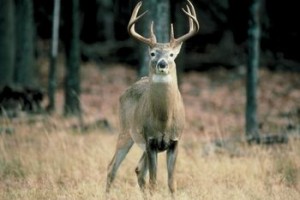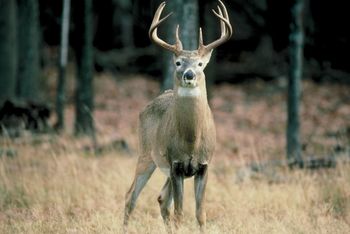 Results of the 2012 Deer Hunter Survey conducted by the S.C. Department of Natural Resources indicate that the statewide harvest of deer last season totaled 217,854, a decrease of 4 percent from last year. An estimated 116,673 bucks and 101,181 does made up this total, according to Charles Ruth, Deer and Wild Turkey Program coordinator for the S.C. Department of Natural Resources (DNR).
Results of the 2012 Deer Hunter Survey conducted by the S.C. Department of Natural Resources indicate that the statewide harvest of deer last season totaled 217,854, a decrease of 4 percent from last year. An estimated 116,673 bucks and 101,181 does made up this total, according to Charles Ruth, Deer and Wild Turkey Program coordinator for the S.C. Department of Natural Resources (DNR).
Since 1997, DNR’s Wildlife Section has employed an annual random mail survey to estimate the harvest of deer at the state and county level. This year’s survey was sent to 25,000 hunters. Prior to 1997 deer harvest figures were dependent on Deer Check Station reports in the 18-county Upstate and reports from hunt clubs in the 28-county Coastal Plain. “The old way of documenting the deer harvest had flaws including failure to report harvested deer and the fact that there was no reporting required in many cases. Based on the survey work that has been done since 1997, it appears that the old system was documenting only about half of the deer being harvested annually in South Carolina, which is exactly why DNR is now using the survey technique,” said Ruth. Increasing rapidly through the 1970s and 1980s, the deer population in South Carolina has generally been declining over the last 10 years, according to Ruth. The harvest in 2012 was continued that trend, reflecting about a 30 percent overall decline from the record harvest established in 2002. The reduction in harvest seen since 2002 can likely be attributed to a number of factors including habitat change. Although timber management activities stimulated the growth in South Carolina’s deer population in the 1980s, considerable acreage is currently in even-aged pine stands that are greater than 10 years old, a situation that does not support deer densities at the same level as younger stands in which food and cover is more available. Wildlife population densities are directly tied to the habitat and since habitats are always changing, population densities are also always changing.
Also, coyotes are a recent addition to the landscape and are another piece of the puzzle. SCDNR is currently involved in a major study with researchers at the Savannah River Site investigating the affects coyotes are having on the survival of deer fawns. Cumulative data through the first 3 years of the study indicates approximately 70 percent total fawn mortality with coyotes being responsible for approximately 80 percent of these mortalities. If these findings even moderately represent a statewide situation, this “new mortality factor” is clearly involved in the reduction in deer numbers. This is especially true when combined with extremely liberal deer harvests that have been the norm in South Carolina. The final 3 years of the study is attempting to determine if coyote control (trap/kill) leads to increased fawn survival on the area.
Harvest figures, like those provided by the 2012 Deer Hunter Survey, allow DNR biologists to reconstruct the deer population using computer modeling. It is a relatively simple procedure: plug in the number of bucks and does harvested along with age structure and reproductive data and the computer model determines the number of deer that were theoretically in the population prior to harvest. According to this modeling, Ruth said, South Carolinas’ deer population peaked during the mid-1990s with just a bit more than one million deer in the pre-hunt population. Currently, the statewide deer population is estimated at about 750,000.
Top counties for harvest in 2012 included Bamberg, Anderson, Union, Greenwood, and Abbeville and with each of these counties exhibiting harvest rates in excess of 14 deer per square mile, which should be considered extraordinary. Very few areas in the United States consistently yield comparable harvest figures. All areas of South Carolina have long and liberal firearms seasons and the majority of deer (171,451) were taken with centerfire rifles in 2012. Shotguns (21,568 deer) and archery equipment (14,814 deer) also contributed significantly to the overall deer harvest, whereas muzzleloaders, crossbows and handguns combined (10,022 deer) produced less than 5 percent of the total statewide harvest.
Although the annual Deer Hunter Survey focuses on deer hunting activities, there are questions on the survey related to the harvest of wild hogs and coyotes in the State. Results of this year’s survey indicate that approximately 28,211 coyotes were taken incidental to deer hunting, down 12 percent from 2011. On the other hand, approximately 26,674 wild hogs were killed statewide representing a 17 percent decrease from 2011. Other survey statistics indicate that approximately 127,369 South Carolina residents and 14,738 non-residents deer hunted in the state in 2012. Deer hunters reported an overall success rate of 68 percent, which is outstanding. Resident hunters averaged about 16 days of deer hunting, non-residents about 14 days, and the total effort expended deer hunting in 2012 was estimated at 2,224,653 days. “The number of days devoted to deer hunting in South Carolina is very significant and points not only to the availability and popularity of deer as a game species, but to the obvious economic benefits related to this important natural resource,” Ruth said. About $200 million in direct retail sales is related to deer hunting in South Carolina annually.
Complete details of the 2012 Deer Harvest Report is available on the SCDNR Web site at the following address:http://www.dnr.sc.gov/wildlife/deer/2012DeerHarvestReport.html


Pingback: Statewide Deer harvest Decreases Slightly in 2012 – Edgefieldadvertiser Hunting Report Archery Duck Deer Hunting Report Archery Duck Deer Hunting